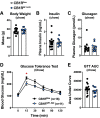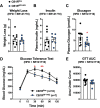CB1Rs in VMH neurons regulate glucose homeostasis but not body weight
- PMID: 34097543
- PMCID: PMC8321828
- DOI: 10.1152/ajpendo.00044.2021
CB1Rs in VMH neurons regulate glucose homeostasis but not body weight
Abstract
Cannabinoid 1 receptor (CB1R) inverse agonists reduce body weight and improve several parameters of glucose homeostasis. However, these drugs have also been associated with deleterious side effects. CB1R expression is widespread in the brain and in peripheral tissues, but whether specific sites of expression can mediate the beneficial metabolic effects of CB1R drugs, while avoiding the untoward side effects, remains unclear. Evidence suggests inverse agonists may act on key sites within the central nervous system to improve metabolism. The ventromedial hypothalamus (VMH) is a critical node regulating energy balance and glucose homeostasis. To determine the contributions of CB1Rs expressed in VMH neurons in regulating metabolic homeostasis, we generated mice lacking CB1Rs in the VMH. We found that the deletion of CB1Rs in the VMH did not affect body weight in chow- and high-fat diet-fed male and female mice. We also found that deletion of CB1Rs in the VMH did not alter weight loss responses induced by the CB1R inverse agonist SR141716. However, we did find that CB1Rs of the VMH regulate parameters of glucose homeostasis independent of body weight in diet-induced obese male mice.NEW & NOTEWORTHY Cannabinoid 1 receptors (CB1Rs) regulate metabolic homeostasis, and CB1R inverse agonists reduce body weight and improve parameters of glucose metabolism. However, the cell populations expressing CB1Rs that regulate metabolic homeostasis remain unclear. CB1Rs are highly expressed in the ventromedial hypothalamic nucleus (VMH), which is a crucial node that regulates metabolism. With CRISPR/Cas9, we generated mice lacking CB1Rs specifically in VMH neurons and found that CB1Rs in VMH neurons are essential for the regulation of glucose metabolism independent of body weight regulation.
Keywords: CB1R; SR141716; VMH; glucose metabolism; metabolic homeostasis.
Figures









Similar articles
-
Hypothalamic Ventromedial Lin28a Enhances Glucose Metabolism in Diet-Induced Obesity.Diabetes. 2017 Aug;66(8):2102-2111. doi: 10.2337/db16-1558. Epub 2017 May 26. Diabetes. 2017. PMID: 28550108 Free PMC article.
-
mGluR5 in Astrocytes in the Ventromedial Hypothalamus Regulates Pituitary Adenylate Cyclase-Activating Polypeptide Neurons and Glucose Homeostasis.J Neurosci. 2023 Aug 16;43(33):5918-5935. doi: 10.1523/JNEUROSCI.0193-23.2023. Epub 2023 Jul 28. J Neurosci. 2023. PMID: 37507231 Free PMC article.
-
Selective loss of leptin receptors in the ventromedial hypothalamic nucleus results in increased adiposity and a metabolic syndrome.Endocrinology. 2008 May;149(5):2138-48. doi: 10.1210/en.2007-1200. Epub 2008 Feb 7. Endocrinology. 2008. PMID: 18258679 Free PMC article.
-
Ventromedial hypothalamus glucose-inhibited neurones: A role in glucose and energy homeostasis?J Neuroendocrinol. 2020 Jan;32(1):e12773. doi: 10.1111/jne.12773. Epub 2019 Aug 4. J Neuroendocrinol. 2020. PMID: 31329314 Free PMC article. Review.
-
The rise, fall, and resurrection of the ventromedial hypothalamus in the regulation of feeding behavior and body weight.Physiol Behav. 2006 Feb 28;87(2):221-44. doi: 10.1016/j.physbeh.2005.10.007. Epub 2006 Jan 18. Physiol Behav. 2006. PMID: 16412483 Review.
Cited by
-
Exploring the Therapeutic Potential of Cannabinoid Receptor Antagonists in Inflammation, Diabetes Mellitus, and Obesity.Biomedicines. 2023 Jun 8;11(6):1667. doi: 10.3390/biomedicines11061667. Biomedicines. 2023. PMID: 37371762 Free PMC article. Review.
-
Gpr149 is involved in energy homeostasis in the male mouse.PeerJ. 2024 Jan 25;12:e16739. doi: 10.7717/peerj.16739. eCollection 2024. PeerJ. 2024. PMID: 38282864 Free PMC article.
-
Hypothalamic cannabinoid signaling: Consequences for eating behavior.Pharmacol Res Perspect. 2024 Oct;12(5):e1251. doi: 10.1002/prp2.1251. Pharmacol Res Perspect. 2024. PMID: 39155548 Free PMC article. Review.
-
The ventromedial hypothalamic nucleus: watchdog of whole-body glucose homeostasis.Cell Biosci. 2022 May 26;12(1):71. doi: 10.1186/s13578-022-00799-2. Cell Biosci. 2022. PMID: 35619170 Free PMC article. Review.
-
Elevating levels of the endocannabinoid 2-arachidonoylglycerol blunts opioid reward but not analgesia.Sci Adv. 2024 Nov 29;10(48):eadq4779. doi: 10.1126/sciadv.adq4779. Epub 2024 Nov 29. Sci Adv. 2024. PMID: 39612328 Free PMC article.
References
Publication types
MeSH terms
Substances
Associated data
Grants and funding
LinkOut - more resources
Full Text Sources
Medical
Molecular Biology Databases

